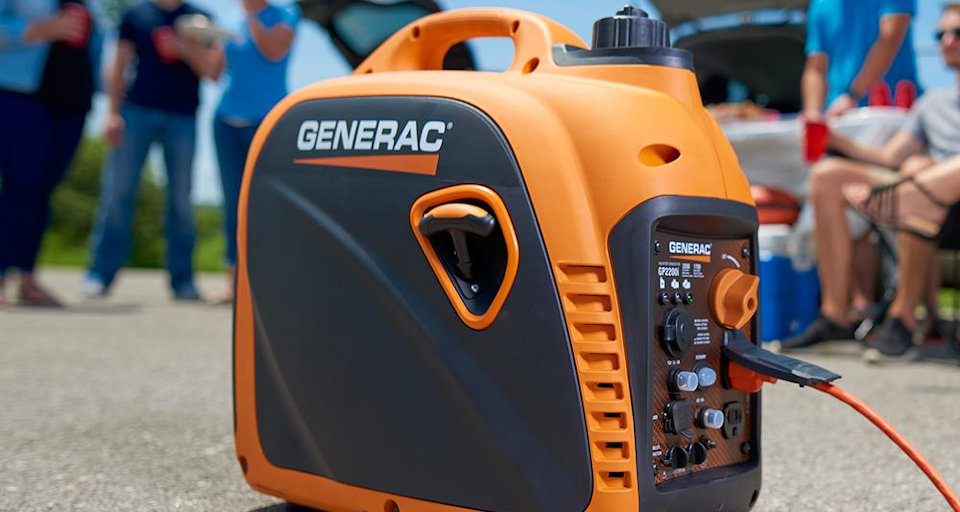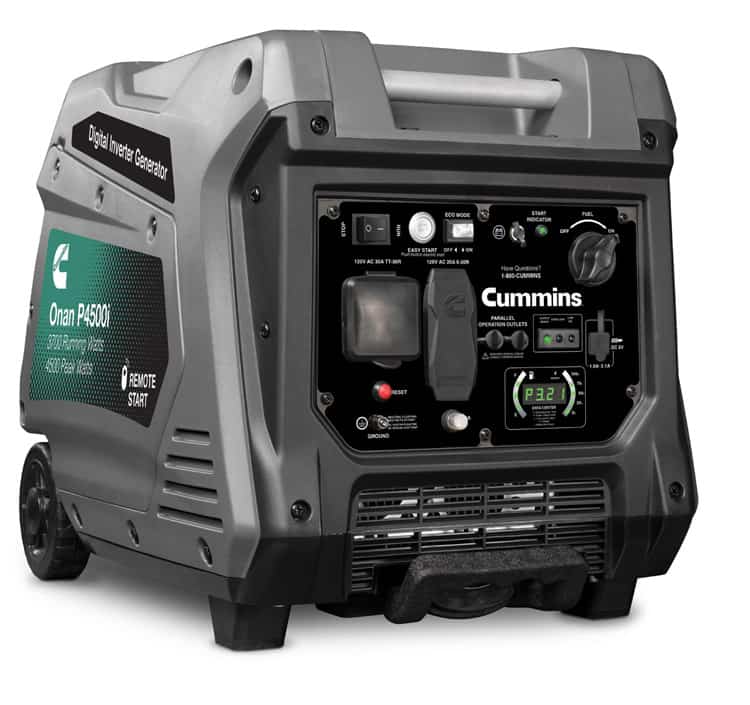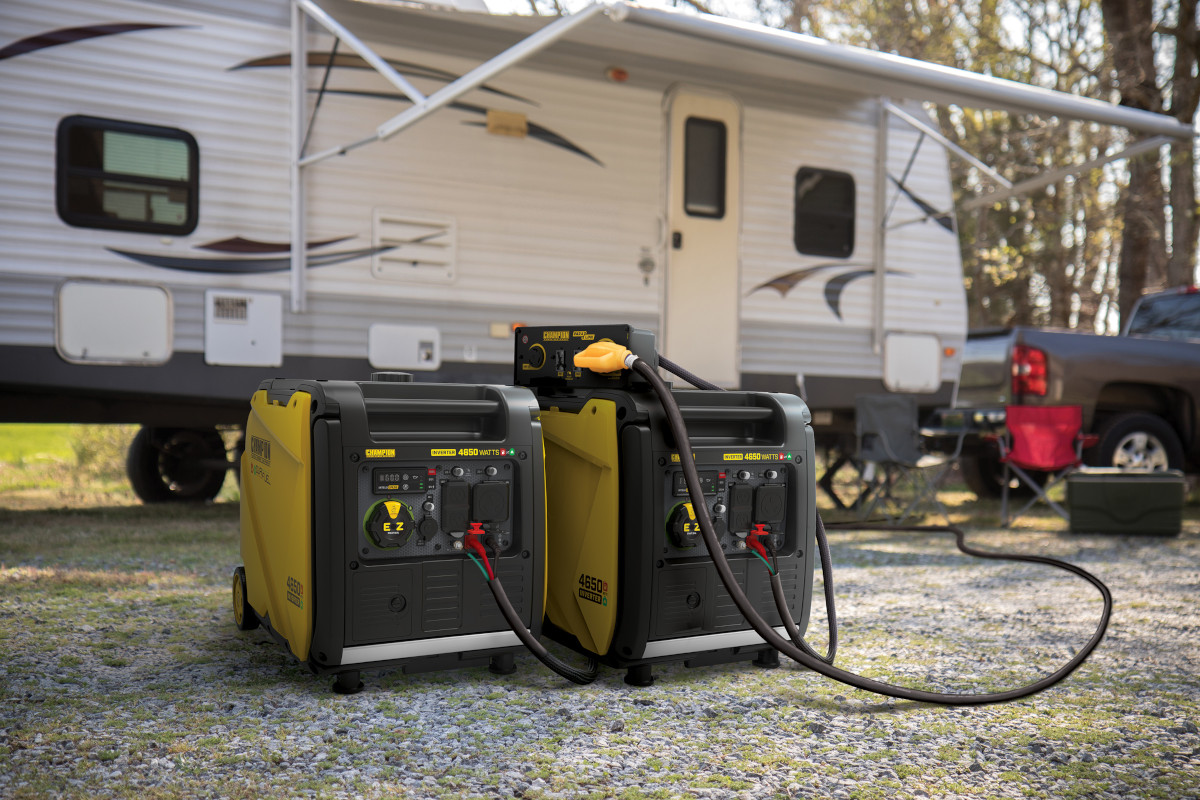Inverter Generator vs Regular Generator: What is the Difference?

Perfect for Camping, Portable Inverter Generators Like the GP2500i are Quiet and Fuel Efficient
When you’re in the market for a portable generator, a number of confusing terms get tossed around. Because of their similarity and the way some of them are often used interchangeably, questions arise as to what exactly is the difference between Portable Generators and Inverter Generators.
They are both generators, and they are both portable, but the way they generate electricity is what makes an inverter generator quieter and more fuel efficient than other portable generators.
How Generators Work
You probably have at least some idea of what a generator is—maybe not how it works—but you know that it produces electricity. A generator converts rotating mechanical energy into electrical energy. Portable generators use an engine—typically running on gasoline, diesel, propane, or natural gas, to turn an alternator which produces alternating electrical current or AC. The utility company supplies Alternating Current (AC) to homes and businesses.
A Power Inverter produces Alternating Current from Direct Current (DC) using electronics. It draws power from a power source such as a car battery or solar panel and uses an electronic circuit to “invert” the direct current (DC) into alternating current (AC). When DC power is inverted into AC electricity, the result is an unvarying electrical signal. Properly filtered, it has the same characteristics as the near-perfect alternating current from the utility and is safe for electronic devices and other sensitive equipment, such as computers and personal laptops.
Ultra-Quiet for Parks & Camps |
Ultra-Quiet Power for RVs |
Backup or Large RVs |
Going Camping? ⛺ Norwall has the Best Inverter Generator
Portable inverter Generators combine the two principles. They generate a variable frequency alternating current that changes with the engine speed. A higher engine speed results in a higher frequency which for our purposes means it is generating more current. A lower engine speed equals less current. The variable frequency current is rectified into DC current. The generator's inverter circuit inverts the DC into an unvarying 60 hertz AC current that is free from glitches, spikes, and surges—a perfect AC signal.
When more current is needed—like when you turn on a few extra lights—the engine speeds up to produce more electricity without varying the frequency of the output current.
On a conventional portable generator, the engine speed is fixed—typically at 3600 RPM—and always runs at that speed. A portable inverter generator varies it's speed to produce the power required. Turn on a few lights and the engine speed increases. Turn them off again and the engine slows down. This is how a portable inverter uses fuel more efficiently. Some portable inverters have engine speed set points. They run at a fixed speed for any power need up to a maximum before their speed increases to the next set point. Fixed engine speeds guard prevent the engine speed from changing too frequently as small loads turn on and off.
Norwall's Portable RV Generator Catalog
Important Difference Between an Inverter and Regular Generator
It's all about having enough power for camping and RVing , tailgating at the game, or keeping a few essentials running during an outage. An Inverter Generator and a Regular Portable Generator can do the job if they have enough power capacity. Many small generators, inverter and portable alike, can't handle some of the bigger jobs. The smallest generators with ratings under 2000 watts may not have enough power to start and run run appliances like refrigerators, freezers, and air conditioners.
Motors require up to 6 times the power to start versus the power required to run. In just one example, a regular home refrigerator might require 900 watts to run, but needs 2700 to start. Many manufacturers name their inverter generator models by the max watts, starting watts, or surge watts capacity. ( Max watts, starting watts, and surge watts are all the same.) Regular portables usually are named for their running watts, but some manufacturers round up the running watts for the name.
- Example: A 4500-Watt Inverter rated at 4500 Starting watts and a 4000 Running watt capacity
- Example: A 4500-Watt Portable is rated at 4500 Running watts and 5500 Starting Watts.
Portable Generator Buyer Guide: What Size Generator Do I Need
Power Quality is another difference between an inverter and portable generator. Clean power matters, especially where computers and other electronics are concerned. Some portables distort the alternating current signal to a significant degree—up to 25% Total Harmonic Distortion (THD) under heavy loads. That much distortion could damage some electronics. Some electronic circuits and devices will detect the distortion and refuse to accept the power.
Related: Understanding Generator Watts Volts and Amps
Most inverters have a very clean signal that never varies. Manufacturers frequently tout less than 3% THD—usually a worst case scenario. For sensitive electronics and appliances with electronics, Inverter Generators are preferable to all but a few regular portables because of their exceptional power quality. For the best power quality, look for true sine wave output in the specifications.
For some jobs, the regular portable generator is just fine. Running power tools. Welding. Electric Compressors and Pumps. Heavy duty equipment. Most Job Site Generators are regular portables that run all day, every day. They have features like idle control and multiple outlets for extension cords and power for many tradesmen.
What is an Inverter Generator?
Efficient Portable Inverter Generators
Conventional portable generators maintain their speed in order to produce electricity. Some have an idle mode that will save fuel when nothing is drawing electricity. As the demand for electricity increases—using a tool or turning on a light bulb—the amount of fuel required increases and so does the noise because the generator engine is working harder.
Inverter generators have to work harder to produce more electricity too, but they start with lower fuel consumption because the engine runs slower when no power is drawn. As more power is needed, the engine increases in speed to produce more power. It's efficient because the engine only uses as much fuel as necessary and only produces as much noise as necessary. Inverter generators produce as little as 53dB(a) of noise.
Another reason for inverter efficiency is the initial method of generating power. A multi-phase variable speed alternator produces electricity nearly as efficient as direct current. The conversion from highly efficient multi-phase current to single phase current is still more efficient than the two-pole alternator found in most portable generators.
✔ Top 5 Inverter Generators for Emergency Power
Benefits of Inverter Generators
The issue of noise distinguishes inverter generators from their portable counterparts. They are designed from the ground up to be much quieter and use special mufflers and sound-dampening technology to reduce noise. Most regular portable generators start at a noise level of 68dB(a) and as the load increases, so does the noise. Higher capacity portables are even louder, some as high 75 to 85 dBA or more. At about twenty feet, it's the difference between shouting to have a conversation and not even raising your voice.
The fluctuating, on-demand nature of inverter generators means that it will adjust its engine speeds to fit the output required. When the load is light, the engine will throttle back, which saves fuel and will substantially reduce noise pollution.
Parallel Technology makes inverter generators even more efficient. At times, you may need minimal power. Later, the need for power increases dramatically. One example might be an RV. On a nice day, the air conditioners don't run and you only need power for the refrigerator and the usual appliances. Hot days power usage is different when all three rooftop air conditioners run. For minimal power use, just use one generator. On hot days, connect two inverter generators in parallel and double your power output. The two generators pictured here supply up to 7300 Running Watts when connected in parallel, twice the rated capacity of a single unit.
That's what makes portable inverter generators perfect for RVing, camping, and tailgating. They do the job without being intrusive and some can run eight hours or more on a gallon of fuel. If you need more power, connect a second generator for up to double the power.
Check out the Norwall Power Calculator to match your power requirements with an inverter generator today.
Updated March 7, 2025




